Ben Liu
Plan Then Retrieve: Reinforcement Learning-Guided Complex Reasoning over Knowledge Graphs
Oct 23, 2025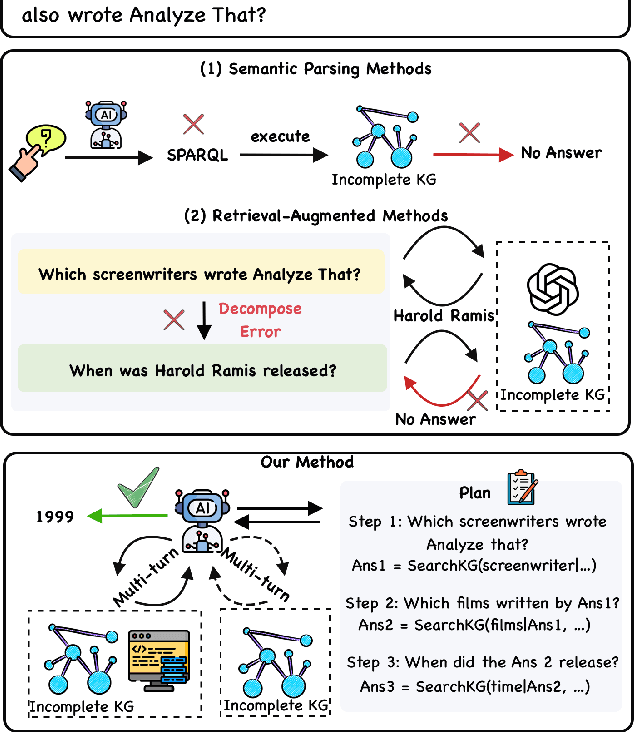

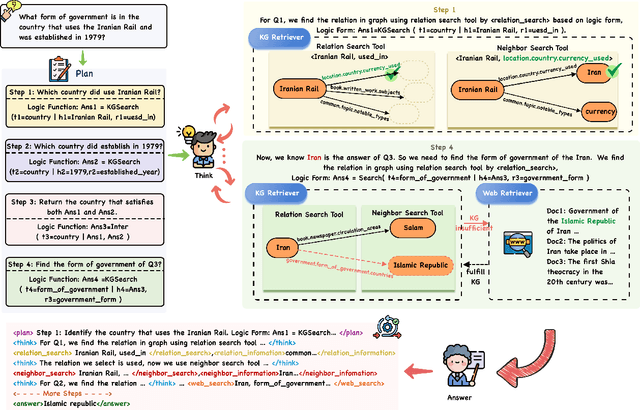
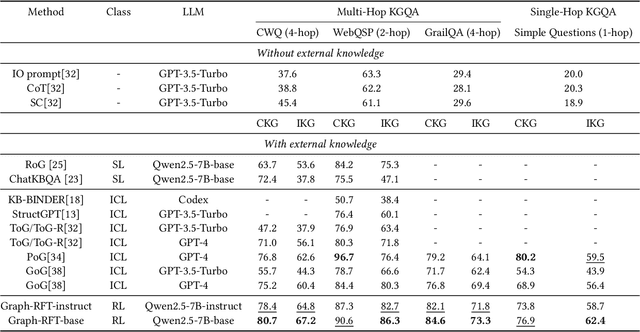
Abstract:Knowledge Graph Question Answering aims to answer natural language questions by reasoning over structured knowledge graphs. While large language models have advanced KGQA through their strong reasoning capabilities, existing methods continue to struggle to fully exploit both the rich knowledge encoded in KGs and the reasoning capabilities of LLMs, particularly in complex scenarios. They often assume complete KG coverage and lack mechanisms to judge when external information is needed, and their reasoning remains locally myopic, failing to maintain coherent multi-step planning, leading to reasoning failures even when relevant knowledge exists. We propose Graph-RFT, a novel two-stage reinforcement fine-tuning KGQA framework with a 'plan-KGsearch-and-Websearch-during-think' paradigm, that enables LLMs to perform autonomous planning and adaptive retrieval scheduling across KG and web sources under incomplete knowledge conditions. Graph-RFT introduces a chain-of-thought fine-tuning method with a customized plan-retrieval dataset activates structured reasoning and resolves the GRPO cold-start problem. It then introduces a novel plan-retrieval guided reinforcement learning process integrates explicit planning and retrieval actions with a multi-reward design, enabling coverage-aware retrieval scheduling. It employs a Cartesian-inspired planning module to decompose complex questions into ordered subquestions, and logical expression to guide tool invocation for globally consistent multi-step reasoning. This reasoning retrieval process is optimized with a multi-reward combining outcome and retrieval specific signals, enabling the model to learn when and how to combine KG and web retrieval effectively.
Whole-body Motion Control of an Omnidirectional Wheel-Legged Mobile Manipulator via Contact-Aware Dynamic Optimization
Sep 17, 2025Abstract:Wheel-legged robots with integrated manipulators hold great promise for mobile manipulation in logistics, industrial automation, and human-robot collaboration. However, unified control of such systems remains challenging due to the redundancy in degrees of freedom, complex wheel-ground contact dynamics, and the need for seamless coordination between locomotion and manipulation. In this work, we present the design and whole-body motion control of an omnidirectional wheel-legged quadrupedal robot equipped with a dexterous manipulator. The proposed platform incorporates independently actuated steering modules and hub-driven wheels, enabling agile omnidirectional locomotion with high maneuverability in structured environments. To address the challenges of contact-rich interaction, we develop a contact-aware whole-body dynamic optimization framework that integrates point-contact modeling for manipulation with line-contact modeling for wheel-ground interactions. A warm-start strategy is introduced to accelerate online optimization, ensuring real-time feasibility for high-dimensional control. Furthermore, a unified kinematic model tailored for the robot's 4WIS-4WID actuation scheme eliminates the need for mode switching across different locomotion strategies, improving control consistency and robustness. Simulation and experimental results validate the effectiveness of the proposed framework, demonstrating agile terrain traversal, high-speed omnidirectional mobility, and precise manipulation under diverse scenarios, underscoring the system's potential for factory automation, urban logistics, and service robotics in semi-structured environments.
Forecast-Then-Optimize Deep Learning Methods
Jun 16, 2025Abstract:Time series forecasting underpins vital decision-making across various sectors, yet raw predictions from sophisticated models often harbor systematic errors and biases. We examine the Forecast-Then-Optimize (FTO) framework, pioneering its systematic synopsis. Unlike conventional Predict-Then-Optimize (PTO) methods, FTO explicitly refines forecasts through optimization techniques such as ensemble methods, meta-learners, and uncertainty adjustments. Furthermore, deep learning and large language models have established superiority over traditional parametric forecasting models for most enterprise applications. This paper surveys significant advancements from 2016 to 2025, analyzing mainstream deep learning FTO architectures. Focusing on real-world applications in operations management, we demonstrate FTO's crucial role in enhancing predictive accuracy, robustness, and decision efficacy. Our study establishes foundational guidelines for future forecasting methodologies, bridging theory and operational practicality.
A Retrieval-Augmented Multi-Agent Framework for Psychiatry Diagnosis
Jun 04, 2025Abstract:The application of AI in psychiatric diagnosis faces significant challenges, including the subjective nature of mental health assessments, symptom overlap across disorders, and privacy constraints limiting data availability. To address these issues, we present MoodAngels, the first specialized multi-agent framework for mood disorder diagnosis. Our approach combines granular-scale analysis of clinical assessments with a structured verification process, enabling more accurate interpretation of complex psychiatric data. Complementing this framework, we introduce MoodSyn, an open-source dataset of 1,173 synthetic psychiatric cases that preserves clinical validity while ensuring patient privacy. Experimental results demonstrate that MoodAngels outperforms conventional methods, with our baseline agent achieving 12.3% higher accuracy than GPT-4o on real-world cases, and our full multi-agent system delivering further improvements. Evaluation in the MoodSyn dataset demonstrates exceptional fidelity, accurately reproducing both the core statistical patterns and complex relationships present in the original data while maintaining strong utility for machine learning applications. Together, these contributions provide both an advanced diagnostic tool and a critical research resource for computational psychiatry, bridging important gaps in AI-assisted mental health assessment.
G-DReaM: Graph-conditioned Diffusion Retargeting across Multiple Embodiments
May 27, 2025Abstract:Motion retargeting for specific robot from existing motion datasets is one critical step in transferring motion patterns from human behaviors to and across various robots. However, inconsistencies in topological structure, geometrical parameters as well as joint correspondence make it difficult to handle diverse embodiments with a unified retargeting architecture. In this work, we propose a novel unified graph-conditioned diffusion-based motion generation framework for retargeting reference motions across diverse embodiments. The intrinsic characteristics of heterogeneous embodiments are represented with graph structure that effectively captures topological and geometrical features of different robots. Such a graph-based encoding further allows for knowledge exploitation at the joint level with a customized attention mechanisms developed in this work. For lacking ground truth motions of the desired embodiment, we utilize an energy-based guidance formulated as retargeting losses to train the diffusion model. As one of the first cross-embodiment motion retargeting methods in robotics, our experiments validate that the proposed model can retarget motions across heterogeneous embodiments in a unified manner. Moreover, it demonstrates a certain degree of generalization to both diverse skeletal structures and similar motion patterns.
Towards Explainable Temporal Reasoning in Large Language Models: A Structure-Aware Generative Framework
May 21, 2025Abstract:While large language models (LLMs) show great potential in temporal reasoning, most existing work focuses heavily on enhancing performance, often neglecting the explainable reasoning processes underlying the results. To address this gap, we introduce a comprehensive benchmark covering a wide range of temporal granularities, designed to systematically evaluate LLMs' capabilities in explainable temporal reasoning. Furthermore, our findings reveal that LLMs struggle to deliver convincing explanations when relying solely on textual information. To address challenge, we propose GETER, a novel structure-aware generative framework that integrates Graph structures with text for Explainable TEmporal Reasoning. Specifically, we first leverage temporal knowledge graphs to develop a temporal encoder that captures structural information for the query. Subsequently, we introduce a structure-text prefix adapter to map graph structure features into the text embedding space. Finally, LLMs generate explanation text by seamlessly integrating the soft graph token with instruction-tuning prompt tokens. Experimental results indicate that GETER achieves state-of-the-art performance while also demonstrating its effectiveness as well as strong generalization capabilities. Our dataset and code are available at https://github.com/carryTatum/GETER.
Accelerate TarFlow Sampling with GS-Jacobi Iteration
May 19, 2025Abstract:Image generation models have achieved widespread applications. As an instance, the TarFlow model combines the transformer architecture with Normalizing Flow models, achieving state-of-the-art results on multiple benchmarks. However, due to the causal form of attention requiring sequential computation, TarFlow's sampling process is extremely slow. In this paper, we demonstrate that through a series of optimization strategies, TarFlow sampling can be greatly accelerated by using the Gauss-Seidel-Jacobi (abbreviated as GS-Jacobi) iteration method. Specifically, we find that blocks in the TarFlow model have varying importance: a small number of blocks play a major role in image generation tasks, while other blocks contribute relatively little; some blocks are sensitive to initial values and prone to numerical overflow, while others are relatively robust. Based on these two characteristics, we propose the Convergence Ranking Metric (CRM) and the Initial Guessing Metric (IGM): CRM is used to identify whether a TarFlow block is "simple" (converges in few iterations) or "tough" (requires more iterations); IGM is used to evaluate whether the initial value of the iteration is good. Experiments on four TarFlow models demonstrate that GS-Jacobi sampling can significantly enhance sampling efficiency while maintaining the quality of generated images (measured by FID), achieving speed-ups of 4.53x in Img128cond, 5.32x in AFHQ, 2.96x in Img64uncond, and 2.51x in Img64cond without degrading FID scores or sample quality. Code and checkpoints are accessible on https://github.com/encoreus/GS-Jacobi_for_TarFlow
Debiasing 6-DOF IMU via Hierarchical Learning of Continuous Bias Dynamics
Apr 13, 2025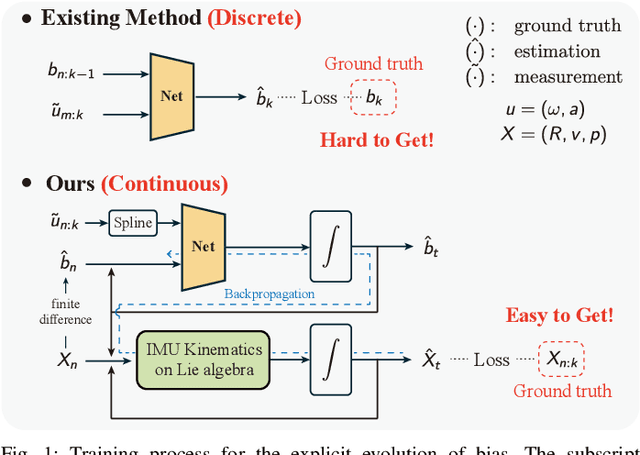
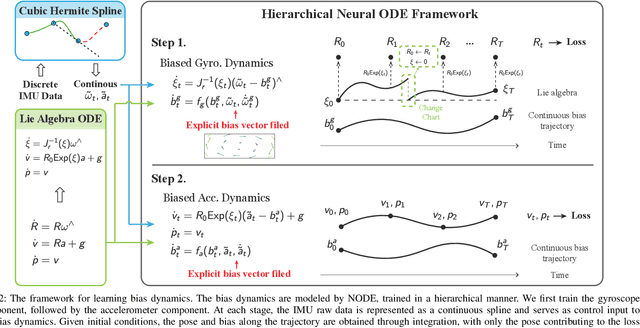

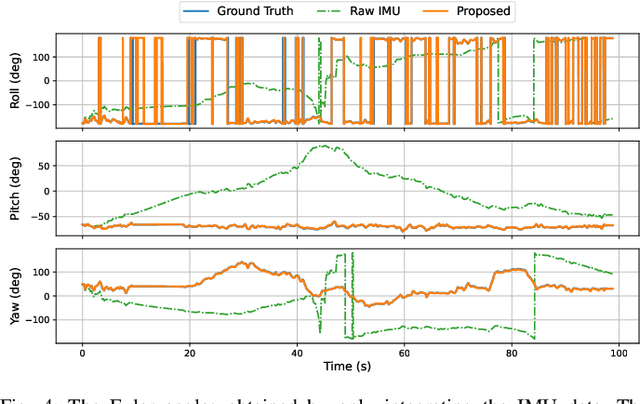
Abstract:This paper develops a deep learning approach to the online debiasing of IMU gyroscopes and accelerometers. Most existing methods rely on implicitly learning a bias term to compensate for raw IMU data. Explicit bias learning has recently shown its potential as a more interpretable and motion-independent alternative. However, it remains underexplored and faces challenges, particularly the need for ground truth bias data, which is rarely available. To address this, we propose a neural ordinary differential equation (NODE) framework that explicitly models continuous bias dynamics, requiring only pose ground truth, often available in datasets. This is achieved by extending the canonical NODE framework to the matrix Lie group for IMU kinematics with a hierarchical training strategy. The validation on two public datasets and one real-world experiment demonstrates significant accuracy improvements in IMU measurements, reducing errors in both pure IMU integration and visual-inertial odometry.
Discrete-Time Hybrid Automata Learning: Legged Locomotion Meets Skateboarding
Mar 03, 2025Abstract:This paper introduces Discrete-time Hybrid Automata Learning (DHAL), a framework using on-policy Reinforcement Learning to identify and execute mode-switching without trajectory segmentation or event function learning. Hybrid dynamical systems, which include continuous flow and discrete mode switching, can model robotics tasks like legged robot locomotion. Model-based methods usually depend on predefined gaits, while model-free approaches lack explicit mode-switching knowledge. Current methods identify discrete modes via segmentation before regressing continuous flow, but learning high-dimensional complex rigid body dynamics without trajectory labels or segmentation is a challenging open problem. Our approach incorporates a beta policy distribution and a multi-critic architecture to model contact-guided motions, exemplified by a challenging quadrupedal robot skateboard task. We validate our method through simulations and real-world tests, demonstrating robust performance in hybrid dynamical systems.
One Size doesn't Fit All: A Personalized Conversational Tutoring Agent for Mathematics Instruction
Feb 19, 2025Abstract:Large language models (LLMs) have been increasingly employed in various intelligent educational systems, simulating human tutors to facilitate effective human-machine interaction. However, previous studies often overlook the significance of recognizing and adapting to individual learner characteristics. Such adaptation is crucial for enhancing student engagement and learning efficiency, particularly in mathematics instruction, where diverse learning styles require personalized strategies to promote comprehension and enthusiasm. In this paper, we propose a \textbf{P}erson\textbf{A}lized \textbf{C}onversational tutoring ag\textbf{E}nt (PACE) for mathematics instruction. PACE simulates students' learning styles based on the Felder and Silverman learning style model, aligning with each student's persona. In this way, our PACE can effectively assess the personality of students, allowing to develop individualized teaching strategies that resonate with their unique learning styles. To further enhance students' comprehension, PACE employs the Socratic teaching method to provide instant feedback and encourage deep thinking. By constructing personalized teaching data and training models, PACE demonstrates the ability to identify and adapt to the unique needs of each student, significantly improving the overall learning experience and outcomes. Moreover, we establish multi-aspect evaluation criteria and conduct extensive analysis to assess the performance of personalized teaching. Experimental results demonstrate the superiority of our model in personalizing the educational experience and motivating students compared to existing methods.
 Add to Chrome
Add to Chrome Add to Firefox
Add to Firefox Add to Edge
Add to Edge